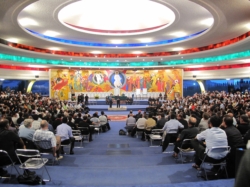From Cardinal Seán’s blog
On Thursday night (Sept. 17), I travelled to Rome for a few days. I was there primarily for meetings with the Congregation of the Bishops, and also to report on my visit to Cuba.
On Saturday, I was invited to attend the final days of a gathering of seminarians from the Neocatechumenal Way in Porto San Giorgio, in the Italian region of Le Marche.
Porto San Giorgio is a tourist oriented town on the Adriatic coast, not too far from Rimini where, a few years ago, I attended another very important event for youth, “Il Meeting” which is organized every year by Communion and Liberation.
Father Antonio Medeiros, the rector of the Redemptoris Mater House of Formation in Boston, our Vocation Director Father Dan Hennessey, and Antonio Enrique, the editor of The Pilot, accompanied me during the trip.
At this retreat, or “convivence” as they are called, prospective seminarians from Neocatechumenal communities from around the world gather and confirm their availability to enter one of the 76 Redemptoris Mater Seminaries around the world, including the one here in Boston.
The men who enter Redemptoris Mater Seminaries receive a formation which is both diocesan and missionary.
In many ways, it is not unlike the St. James Society, which was founded in Boston: diocesan priests who serve a time in the missions ? some more, some less ? but always remaining part of the diocese.
Kiko Arguello, Carmen Hernandez and Father Mario Pezzi ? who are the international team responsible for the Neocatechumenal Way ? have always welcomed me very warmly. They were very supportive of my request to open a Redemptoris Mater House of Formation in Boston several years ago.
To begin their missionary experience, the men entering the seminary are assigned, many of them at random, to seminaries spread over every continent. There, they will learn the local language, culture and one day, hopefully, be ordained as diocesan priests with a missionary spirit. At the Saturday evening sending event, over 250 new seminarians were assigned to different seminaries.
In addition to the new seminarians, there were also current seminarians from Europe and other places where the academic year has not begun yet. So, in all, over 1,000 seminarians and future seminarians attended ? quite an impressive number.
This is the second time I have participated in one of these gatherings. I was very impressed, as I always am, at the willingness of the young men to offer themselves to go anywhere in the world to be formed as diocesan priests.
We received four new seminarians for Boston, two Polish, one Nicaraguan and one American.
It reminds me very much of the spirit that was prevalent in the Church in the years when my own Capuchin community was sending so many people to Papua New Guinea and Puerto Rico. Every year, three, four, or five priests out of every class would be sent.
It is also impressive to see the countries where seminaries have been opened ? including places like Scandinavia or Pakistan where the Church is embryonic at best.
Pope John Paul II, as Bishop of Rome, opened the first Redemptoris Mater Seminary in his diocese in the 1980s. Soon, other bishops asked the Neocatechumenate to help them start seminaries in their own dioceses with that same missionary spirit. Currently, there are six here in the U.S.



















